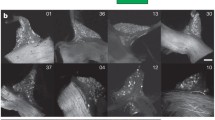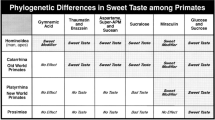Summary
The gustatory sensory system provides animals with a rapid chemical analysis of a potential food substance providing information necessary to facilitate ingestion or rejection of the food. The process of gustatory transduction is initiated in the taste cells in the lingual epithelium. However, due to the small size, scarcity of the cells and their location, embedded in a keratinized squamous epithelium, it has been difficult to study the primary events in the transduction process. Recently, we have developed a preparation of dissociated rat taste cells that permits studies of the taste transduction process in single isolated cells. We have now investigated the electrophysiological properties of the rat taste cells using the patch-clamp technique. We have identified two populations of cells within the taste bud: one expressing a voltage-dependent potassium current and the second containing both voltage-dependent sodium and potassium currents. The potassium current in both cell groups is blocked by external TEA, Ba2+, and quinine. Two types of K+ channels have been identified: a 90-pS delayed rectifier K+ channel and a “maxi” calcium-activated K+ channel. The sodium current is blocked by TTX, but not by amiloride.
Similar content being viewed by others
References
Akabas, M.H., Dodd, J., Al-Awqati, Q. 1987. Mechanism of bitter taste transduction by rat taste cells.J. Cell Biol. 105:93a
Akabas, M.H., Dodd, J., Al-Awqati, Q. 1988. A bitter substance induces a rise in intracellular calcium in a subpopulation of rat taste cells.Science 242:1047–1050
Akisaka, T., Oda, M. 1978. Taste buds in the vallate papillae of the rat studied with freeze-fracture preparation.Arch. Histol. Jpn. 41:87–98
Avenet, P., Hofmann, F., Lindemann, B. 1988. Transduction in taste receptor cells requires cAMP-dependent protein kinase.Nature (London) 331:351–354
Avenet, P., Lindemann, B. 1987. Patch-clamp study of isolated taste receptor cells of the frog.J. Membrane Biol. 97:223–240
Avenet, P., Lindemann, B. 1988. Amiloride-blockable sodium currents in isolated taste receptor cells.J. Membrane Biol. 105:245–255
Biedler, L.M., Smallman, R.L. 1965. Renewal of cells within taste buds.J. Cell Biol. 27:263–272
Brand, J.G., Bryant, B.P., Cagan, R.H., Kalinoski, D.L. 1987. Biochemical studies of taste sensation: XIII. Enantiomeric specificity of alanine taste receptor sites in catfish,Ictalurus punctatus. Brain Res. 416:119–128
Brand, J.G., Teeter, J.H., Silver, W.L. 1985. Inhibition by amiloride of chorda tympani responses evoked by monovalent salts.Brain Res. 334:207–214
Cagan, R.H., Boyle, A.G. 1984. Biochemical studies of taste sensation: XI. Isolation, characterization and taste ligand binding activity of plasma membranes from catfish taste tissue.Biochim. Biophys. Acta 799:230–237
Caprio, J., Byrd, R. 1984. Electrophysiological evidence for acidic, basic and neutral amino acid olfactory receptor sites in the catfish.J. Gen. Physiol. 84:403–422
Delay, R.J., Kinnamon, J.C., Roper, S.D. 1986. Ultrastructure of mouse vallate taste buds: II. Cell types and cell lineage.J. Comp. Neurol. 253:242–252
DeSimone, J.A., Ferrell, F. 1985. Analysis of amiloride inhibition of chorda tympani taste response of rats to NaCl.Am. J. Physiol. 249:R52-R61
Farbman, A.I. 1965. Fine structure of the taste bud.J. Ultrastruct. Res. 12:328–350
Frank, M.E. 1975. Response patterns of the rat glossopharyngeal taste neurons.In: Olfaction and Taste V. D.A. Denton and J.P. Coghlan, editors. pp. 59–64. Academic, New York
Frank, M.E., Contreras, R.J., Hettinger, T.P. 1983. Nerve fibers sensitive to ionic taste stimuli in chorda tympani of the rat.J. Neurosci. 50:941–960
Garty, H., Edelman, I.S. 1983. Amiloride-sensitive trypsinization of apical sodium channels. Analysis of hormonal regulation of sodium transport in toad bladder.J. Gen. Physiol. 81:785–803
Hamill, O.P., Marty, A., Neher, E., Sakmann, B., Sigworth, F.J. 1981. Improved patch-clamp techniques for high-resolution current recording from cells and cell-free membrane patches.Pfluegers Arch. 391:85–100
Heck, G.L., Mierson, S., DeSimone, J.A. 1984. Salt taste transduction occurs through an amiloride-sensitive sodium transport pathway.Science 223:403–405
Hille, B. 1984. Ionic Channels of Excitable Membranes. Sinauer, Sunderland, Mass.
Holland, V.F., Zampighi, G.A., Simon, S.A. 1989. Morphology of fungiform papillae in canine lingual epithelium: Location of intercellular junctions in the epithelium.J. Comp. Neurol. 279:13–27
Hwang, P.M., Verma, A., Bredt, D.S., Verma, D., Snyder, S.H. 1989. Evidence for INS(1,4,5)P3 as a second messenger in rat taste receptor cell signal transduction.Soc. Neurosci. Abstr. 15:752
Jakinovich, W., Jr., Sugarman, D. 1988. Sugar taste reception in mammals.Chem. Senses 13:13–31
Kinnamon, J.C., Taylor, B.J., Delay, R.J., Roper, S.D. 1985. Ultrastructure of mouse vallate taste buds: I. Taste cells and their associated synapses.J. Comp. Neurol. 235:48–60
Kinnamon, S.C., Dionne, V.E., Beam, K.G. 1988. Apical localization of K+ channels in taste cells provides the basis for sourtaste transduction.Proc. Natl. Acad. Sci. USA 85:7023–7027
Kinnamon, S.C., Roper, S.D. 1988. Membrane properties of isolated mudpuppy taste cells.J. Gen. Physiol. 91:351–371
Mierson, S., Heck, G.L., DeSimone, S.K., Biber, T.U.L., DeSimone, J.A. 1985. The identity of the current carriers in canine lingual epithelium in vitro.Biochim. Biophys. Acta 816:283–293
Murray, R.G., Murray, A., Fujimoto, S. 1969. Fine structure of gustatory cells in rabbit taste buds.J. Ultrastr. Res. 127:444–461
Nagahama, S., Kobatake, Y., Kurihara, K. 1982. Effect of Ca2+, cyclic GMP, and cyclic AMP added to artificial solution perfusing lingual artery on frog gustatory nerve responses.J. Gen. Physiol. 80:785–800
Ozeki, M. 1971. Conductance changes associated with receptor potentials of gustatory cells in rat.J. Gen. Physiol. 58:688–699
Pfaff, D.W. (editor) 1985. Taste, Olfaction and the Central Nervous System. Rockefeller University Press, New York
Roper, S.D. 1989. The cell biology of vertebrate taste receptors.Annu. Rev. Neurosci. 12:329–353
Roper, S.D., McBride, D.W., Jr. 1989. Distribution of ion channels on taste cells and its relationship to chemosensory transduction.J. Membrane Biol. 109:29–39
Sato, T. 1980. Recent advances in the physiology of taste cells.Prog. Neurobiol. 14:25–67
Schiffman, S.S., Hopfinger, A.J., Mazur, R.H. 1986. The search for receptors that mediate sweetness.In: The Receptors. Vol. IV, pp. 315–377. P.M. Conn, editor. Academic, New York
Schiffman, S.S., Lockhead, E., Maes, F.W. 1983. Amiloride reduces the taste intensity of Na+ and Li+ salts and sweeteners.Proc. Natl. Acad. Sci. USA 80:6136–6140
Simon, S.A., Robb, R., Schiffman, S.S. 1988. Transport pathways in rat lingual epithelium.Pharmacol. Biochem. Behav. 29:257–267
Spitzer, N.C. 1979. Ion channels in development.Annu. Rev. Neurosci. 2:363–397
Striem, B.J., Pace, U., Zehavi, U., Naim, M., Lancet, D. 1989. Sweet tastants stimulate adenylate cyclase coupled to GTP-binding protein in rat tongue membranes.Biochem. J. 260:121–126
Author information
Authors and Affiliations
Rights and permissions
About this article
Cite this article
Akabas, M., Dodd, J. & Al-Awqati, Q. Identification of electrophysiologically distinct subpopulations of rat taste cells. J. Membrain Biol. 114, 71–78 (1990). https://doi.org/10.1007/BF01869386
Received:
Revised:
Issue Date:
DOI: https://doi.org/10.1007/BF01869386




